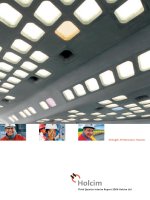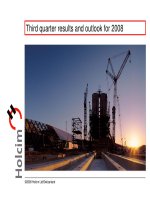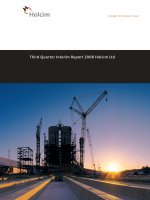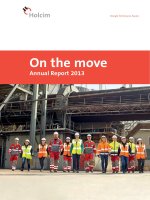Investor presentation january 2009 holcim ltd 2009
Bạn đang xem bản rút gọn của tài liệu. Xem và tải ngay bản đầy đủ của tài liệu tại đây (956.03 KB, 29 trang )
© Holcim Ltd 2009
Investor Presentation
January 2009
2
© Holcim Ltd 2009
January 2009
Investor Presentation
Agenda
1
An attractive industry
2
Holcim is the strongest player in the industry
3
Our priorities in the difficult environment
4
Conclusion
3
© Holcim Ltd 2009
January 2009
Investor Presentation
0
500
1000
1500
2000
2500
3000
3500
1973 1978 1983 1988 1993 1998 2003 2008
World [Mt] World w/o China [Mt]
Recession
Asian
Crisis
RecessionRecessionOil
Crisis
Recession
Even during recessionary periods, cement demand
has historically held up well and recovered quickly
Assumption: China grew by 10% per annum before 1990
Source: Cembureau, The Global Cement Report 7th Edition, Holcim Estimates
Demand (CAGR)
2001-2003
World: +7.7%
Americas: -0.3%
West Europe: +1.5%
Asia (incl. CN): +10.2%
Demand (CAGR)
1997-1998
World: +0.5%
Americas: +4.8%
West Europe: +5.6%
Asia (incl. CN): -2.1%
Demand (CAGR)
1989-1991
World: +0.5%
Americas: -2.4%
West Europe: -3.3%
Asia (incl. CN): 7.3%
Demand (CAGR)
1981-1983
World: +1.8%
Americas: -4.2%
West Europe: -2.2%
Asia (incl. CN): 7.9%
Demand (CAGR)
1973-1975
World: -0.1%
Americas: -4.8%
West Europe: -2.8%
Asia (incl. CN): 1.4%
CAGR 1973-2007 (World): 4.1%
CAGR 1973-2007 (World w/o China): 2.3%
Cement Demand (Mt)
4
© Holcim Ltd 2009
January 2009
Investor Presentation
Attractiveness of the heavy-side building materials
The basis of cement and aggregates investments are large
scale
Hedge against inflation (real value)
No technical obsolescence
Cement and aggregates do not go out of fashion
Raw material reserves for decades
Distribution, logistics and transportation network
requirements
Limited substitution potential
Relative demand inelasticity
Housing and infrastructure requirements are basic needs
Concrete is the second most used commodity after water and
is an eco-friendly building material
5
© Holcim Ltd 2009
January 2009
Investor Presentation
Asian
Crisis
Recession Recession
Construction material has lower volatility compared
to other industries
Source: Datastream
Industrial Stock Indices Evolution 1995 - 2008
50
250
450
650
01.95 01.97 01.99 01.01 01.03 01.05 01.07
MSCI World
Constr. Mat.
MSCI World
Energy
MSCI World Health
Care
MSCI World
Financials
MSCI World IT
6
© Holcim Ltd 2009
January 2009
Investor Presentation
50
60
70
80
90
100
110
07.07 08.07 09.07 10.07 11.07 12.07 01.08 02.08 03.08 04.08 05.08 06.08 07.08 08.08
MSCI World Constr. Mat. MSCI World
The building material industry is hurt first when talking
about cooling down of the economy
The industry is hurt first in difficult times, but…
MSCI Construction vs. MSCI World (15 July 2007 – 15 September 2008)
Source: Datastream
7
© Holcim Ltd 2009
January 2009
Investor Presentation
Barrack Obama announcement of infrastructure plan
China's announcement of infrastructure spending
30
40
50
60
70
80
90
100
110
01.10.08 01.11.08 01.12.08 01.01.09
Major US Basic Build. Mat. supplier (Index)* Holcim
Construction Spending Programme
announced by Barrack Obama
0
20
40
60
80
100
120
140
160
01.10.08 01.11.08 01.12.08 01.01.09
MSCI China Huaxin
China's cabinet announces
infrastructure and housing spending
* Holcim, Cemex, Lafarge, Vulcan, Martin Marietta
… stands first in line to profit from proposed
government stimulation programs
Source: Datastream, Bloomberg, Economist
1
The Economist Dec. 11, 2008, recent discussions indicate much more
“Single largest new investment”
since the Eisenhower
Administration (US$ 300bn/y
1
[2% of GDP] expected)
Construction spending in
roads, bridges and public
buildings
to lift the sagging economy
and create jobs
Government announcement of
stimulus plan of ~US$ 600bn
(most already committed)
8
© Holcim Ltd 2009
January 2009
Investor Presentation
Massive fiscal stimulus initiatives have been
announced, and more are potentially in the making
No stimulus or not known
Expected soon
Announced stimulus
Stimulus estimated at US$ 1.8-2.3 trillion or 3.5% of world GDP
200 200
170
50
4
100
200 200 200 200 200
200
24
100
132
33
62
30
8
USD billions, known status January 12th, 2009
Note: Includes only major countries and excludes EU package (additional announced packages account for up to 8.2% of world GDP)
Source: Reuters, Bloomberg, Economist, plus miscellaneous other media sources, GDP data IMF October 2008
World GDP 2008
US$ 62 trillion
14
50
9
© Holcim Ltd 2009
January 2009
Investor Presentation
Stimulus initiatives would significantly help
economies maintain or regain growth
Packages are significant – estimated country GDP impact varies
from 0.1% to 8.1% per annum
Key mature and emerging markets show the power and initiative to
implement fiscal stimulus and manage their economy
Important will be the real implementation rate, response speed
Infrastructure is a key part of many stimulus programs
Potential multiplier effect would add further stimulus
2
1
Calculated on IMF October 2008 GDP forecast, simulation with 40% spent in 2009 and 60% spent in 2010.
2
Keynes “Multiplier effect” has not been simulated – however in theory this mechanic should add further economic stimulus.
Source: Reuters, Bloomberg, Economist, plus miscellaneous other media sources, IMF October 2008 (GDP data)
Holcim is positioned well to gain from the stimulus initiatives
Potential estimated
1
impact on GDP growth (assumption split 40% in 2009 and 60% in 2010)
2.9%
0.4%
5.4%
0.4%
1.4%
0.1%
1.7%
0.5%
2.2%
1.5%
2.8%
4.3%
0.6%
8.1%
0.7%
2.1%
0.2%
2.5%
0.8%
3.4%
2.2%
4.2%
Argentina Britan China France Germany India Italy Mexico Russia Spain USA
2009
2010
10
© Holcim Ltd 2009
January 2009
Investor Presentation
Construction: stimulus projects add up to
~US$ 430-680bn, mainly focused on infrastructure
?
?
?
1
Construction market in OECD countries is between 4% and 7% of GDP. Assumed to be an average of 6% of world GDP equaling
US$3.7trillions, assumption calculated for implementation of US$ 430-680 bn during one year
2
Range of construction stimulus projects in the US; as of Jan. 09. 2009 (Goldman Sachs and others)
3
Mostly consumed nationally, therefore impacting export
Source: Reuters, Bloomberg, Economist, plus other sources, IMF Oct. 2008 (GDP data), OECD Dec. 2008 (Construction % share)
?
= infrastructure or construction stimulus announced
= expected to announce (further) infrastructure stimulus
= Holcim Group presence
Known stimulus projects as of January 12th, 2009
US$ ~150-350bn
2
US$ ~30bn
US$ ~100bn
3
Projects equal approx. 12%-18%
1
of world construction market
11
© Holcim Ltd 2009
January 2009
Investor Presentation
Infrastructure spending translates into demand for
building materials
Source: Holcim data, pictures from google.com
One km of concrete tunnel (2x2 lane) requires:
18,000 m
3
of concrete
8,000 tonnes cement
48,000 tonnes aggregates
One km of concrete pavement highway (2x2 lane) requires:
7,200 m
3
of concrete
3,300 tonnes cement
85,000 tonnes aggregates
100 meter concrete bridge (2x2 lane) requires:
2,400 m
3
of concrete
900 tonnes cement
4,300 tonnes aggregates
Project example from Germany
Project example from Croatia
Project example from Croatia
12
© Holcim Ltd 2009
January 2009
Investor Presentation
Rural areas are not as dependent on financial
markets or monetary policy
Rural market demand is more impacted by
Agricultural productivity gains and crop yields
Population growth and migration trends
Water and power generation availability
Regional food supply and demand dynamics
Household savings rates
Brand recognition and commercial initiatives are also
important factors in rural markets
Retail market sold predominantly in bags
Reliance on do-it-yourself (DIY) market
13
© Holcim Ltd 2009
January 2009
Investor Presentation
Agenda
1
An attractive industry
2
Holcim is the strongest player in the industry
3
Our priorities in the difficult environment
4
Conclusion
14
© Holcim Ltd 2009
January 2009
Investor Presentation
EBITDA contribution where Holcim holds a number
one, two or three position based on cement volumes
Mature Markets Emerging Markets
Holcim targets to be one of the top 3 players in its
core markets
# three
48%
# two
17%
# one
20%
others
15%
# three
13%
# two
65%
# one
18%
others
4%
15
© Holcim Ltd 2009
January 2009
Investor Presentation
Emerging markets offer significant growth potential
– Example India
In India, more than 72% of population is rural
Individual Home Builder (IHB) make up 45% of market
Projected rural housing creation estimated at 40 million
units over the next 15 years
1
Marketing focus on rural and low cost housing needs
“ACC help” designed to support IHBs in every aspect
including libraries, website, home plans, testing, etc.
Agreement with internet provider (ITC E-Choupal) to
establish direct access to agricultural community
Expansion of rural distribution network through
partnerships and agreements
Low cost housing initiatives (<10 US$/sq. ft.) based on
thin-shell material providing low-weight and long life
1
Based on historical growth estimates, current actual shortfall is approximately 40 million units expected to grow by 3% p.a. until 2025
Source: Internal estimates
16
© Holcim Ltd 2009
January 2009
Investor Presentation
Example of a low cost housing in India
17
© Holcim Ltd 2009
January 2009
Investor Presentation
Sources: Holcim, US Census Bureau, Economist Intelligence Unit
The resulting cement portfolio is well balanced
-4%
-2%
0%
2%
4%
6%
8%
10%
12%
1% 2% 3% 4% 5% 6% 7% 8% 9% 10% 11%
GDP per capita (at PPP) CAGR 08-13E
Cumulated population
growth 08-13E
Mature markets Emerging markets
Size of circles represents influenced capacity 2007
Western
Europe
27.7 Mt
Eastern
Europe
22.5 Mt
Africa
Middle East
21.8 Mt
Cement
demand
growth
North
America
22.3 Mt
India
42.9 Mt
China
31.4 Mt
Asia Pacific
excl. India
and China
48.3 Mt
Latin
America
38.2 Mt
18
© Holcim Ltd 2009
January 2009
Investor Presentation
-4%
-2%
0%
2%
4%
6%
8%
10%
12%
1% 2% 3% 4% 5% 6% 7% 8% 9% 10% 11%
Cumulated population
growth 08-13E
Western Europe
100.3 Mt
Africa
Middle East
1
5.7 Mt
Latin
America
12.5 Mt
North
America
56.9 Mt
Asia
4.0 Mt
GDP per capita (at PPP) CAGR 08-13E
Mature markets Emerging markets
Size of circles represents consolidated sales volumes 2007
Eastern
Europe
8.5 Mt
1
Incl. 5 months of South Africa (aggregates sales of 3.6 Mt)
Sources: Holcim, US Census Bureau, Economist Intelligence Unit
and complemented by a strong position in the
most attractive aggregates markets
19
© Holcim Ltd 2009
January 2009
Investor Presentation
0 20406080100
Best Average Holcim
Corporate Governance
Risk & Crisis Management
Codes of Conduct/Compliance/Corruption&Bribery
Customer Relationship Management
A
ntitrust Policy
Environmental Reporting
Environmental Policy/Management System
Operational Eco-Efficiency
Biodiversity
Recycling Strategy
Climate Strategy
Transport and Logistics
International Production Standards
Labor Practice Indicators
Human Capital Development
Talent Attraction & Retention
Corporate Citizenship/Philanthropy
Social Reporting
Stakeholder engagement
Occupational Health & Safety
Standards for Suppliers
Industry Average Holcim Average
2008 Results [%]
Economic Dimension
Environmental Dimension
Social Dimension
Holcim 4 times leader (‘05-’08) in the Dow Jones
Sustainability Index for Building Mat. & Fixtures
Source: Dow Jones Sustainability Indexes
20
© Holcim Ltd 2009
January 2009
Investor Presentation
Agenda
1
An attractive industry
2
Holcim is the strongest player in the industry
3
Our priorities in the difficult environment
4
Conclusion
21
© Holcim Ltd 2009
January 2009
Investor Presentation
Cash flow is the focus
Minimize investment to maintain in 2009 (net CHF 0.4bn vs.
1.2bn in 2008) will only approve projects with short term
payback periods
Commissioning of most of the additional expansion projects
in the pipeline in 2009 (CHF 2.5bn vs. 3.5bn in 2008) no
new investments
Focus on free operating cash flow
Cost management and timely capacity adjustments are
paramount in all segments
Crisis-proven management at corporate and regional level:
Learning from previous crises Mexico, Latin America,
Asia, Russia
Leveraging current know-how from operations in more than
70 countries
Holcim is well prepared for challenging times
ahead
22
© Holcim Ltd 2009
January 2009
Investor Presentation
Capacity adjustments and cost management are
paramount in all segments
USA:
Closing 2 cement plants
Closing 65 ready-mix,
aggregates, asphalt &
concrete product plants
Reduction-in-force of 2,000
Spain:
Closing 1 cement plant
Closing 23 ready-mix and
aggregates plants
Reduction-in-force of 450
UK:
Closing 20 ready-mix, asphalt
and aggregates plants
Reduction-in-force of 600
Philippines:
Mothballed 1 kiln
Thailand:
Mothballed 2 kiln lines
Reduction-in-force of 280
Holcim is responding fast to the economic challenge
Note: Select cost and capacity initiatives – largely completed in 2008 as communicated with Q3 2008 (November 12, 2008) – are
highlighted using estimated numbers.
Sample of initiatives in execution
23
© Holcim Ltd 2009
January 2009
Investor Presentation
Strong liquidity
Very limited short-term refinancing needs
Low leverage
Well diversified financings
No financial covenants at corporate level
A strong bank relationship management (no large exposure
to any single bank)
Holcim has a solid balance sheet and adequate
liquidity
(prerequisites in dysfunctional credit markets)
Holcim is well positioned to manage the downturn
24
© Holcim Ltd 2009
January 2009
Investor Presentation
0
1
2
3
4
5
6
<1y2y3y4y5y6y7y8y9y10y>10y
Loans
Capital markets
Maturity profile (CHF billion)
1
Liquidity summary
2
Liquidity II: CHF 3.7 billion
Liquidity III: CHF 5.7 billion
Debt summary
Fixed to floating ratio: 32% Fixed
Capital markets 43%; loans 57%
Corporate vs. subsidiary debt: 79% Corporate
Ø Total maturity: 3.7 years
CP Borrowings: EUR 424 million
New financings since September 30, 2008
More than CHF 500 million
Ratings summary as of January 15, 2009
S&P Credit Rating: BBB+ LT outlook negative
Fitch Credit Rating: BBB+ LT outlook negative
Moody’s Credit Rating: Baa1 LT outlook negative
1
Current financial liabilities adjusted for short-term drawings under-long term committed credit lines
2
Liquidity II =Cash + marketable securities
Liquidity III =Liquidity II + unused committed credit lines
0.0
0.1
0.2
0.3
0.4
0.5
0.6
ONDJFMAMJ JASOND
Capital markets
2008 2009
Financial debt, maturities and liquidity as of Q3
2008 (no significant change since)
25
© Holcim Ltd 2009
January 2009
Investor Presentation
Agenda
1
An attractive industry
2
Holcim is the strongest player in the industry
3
Our priorities in the difficult environment
4
Conclusion









